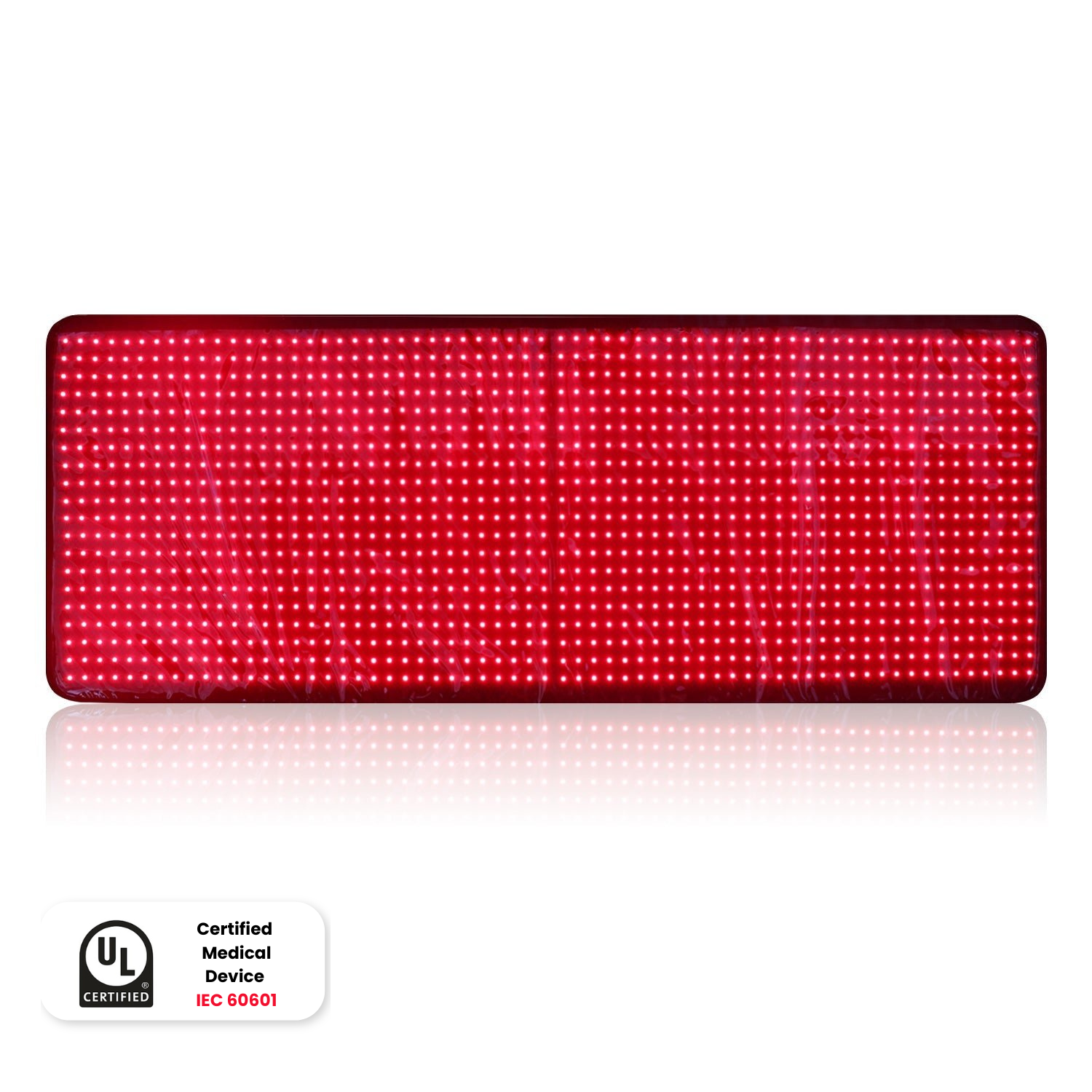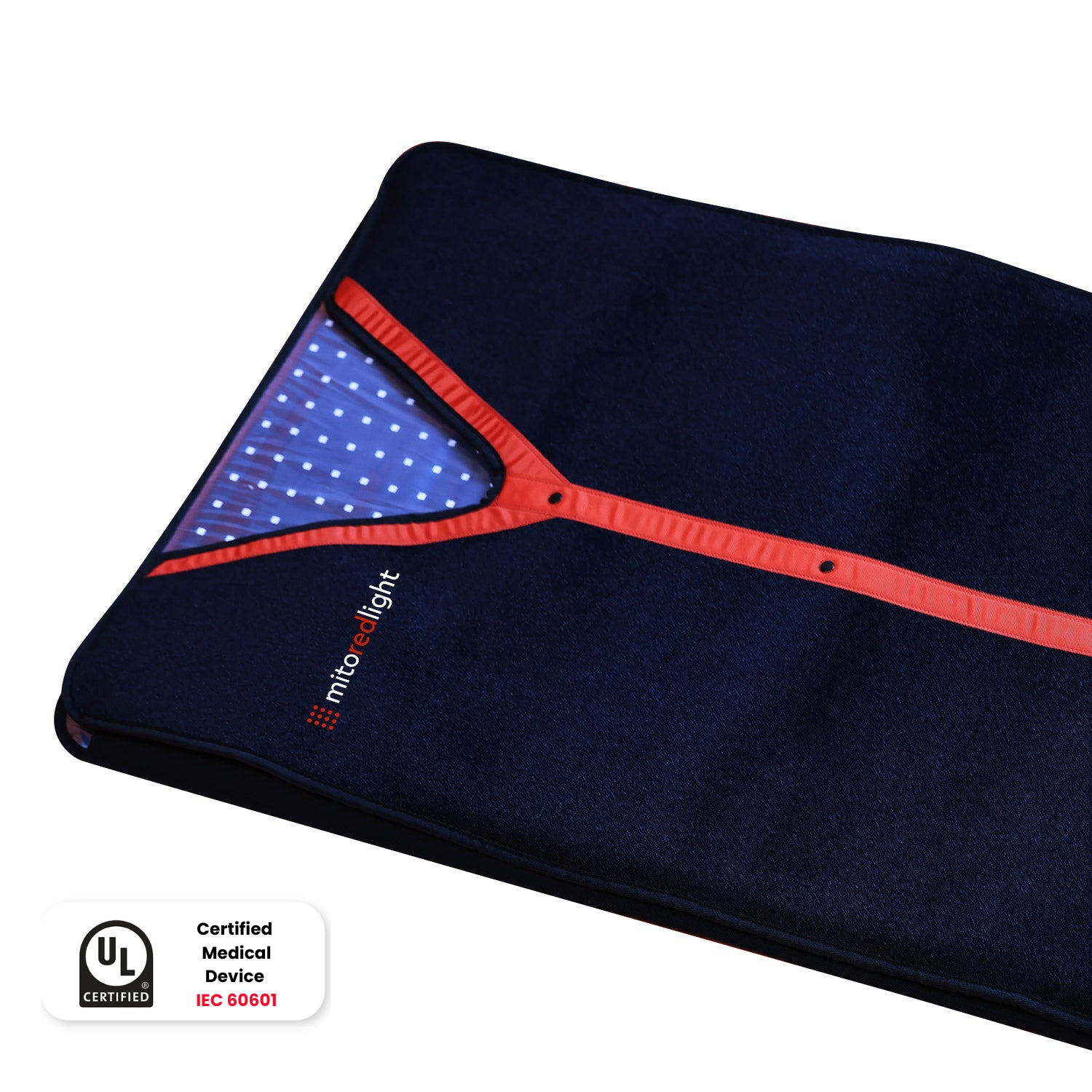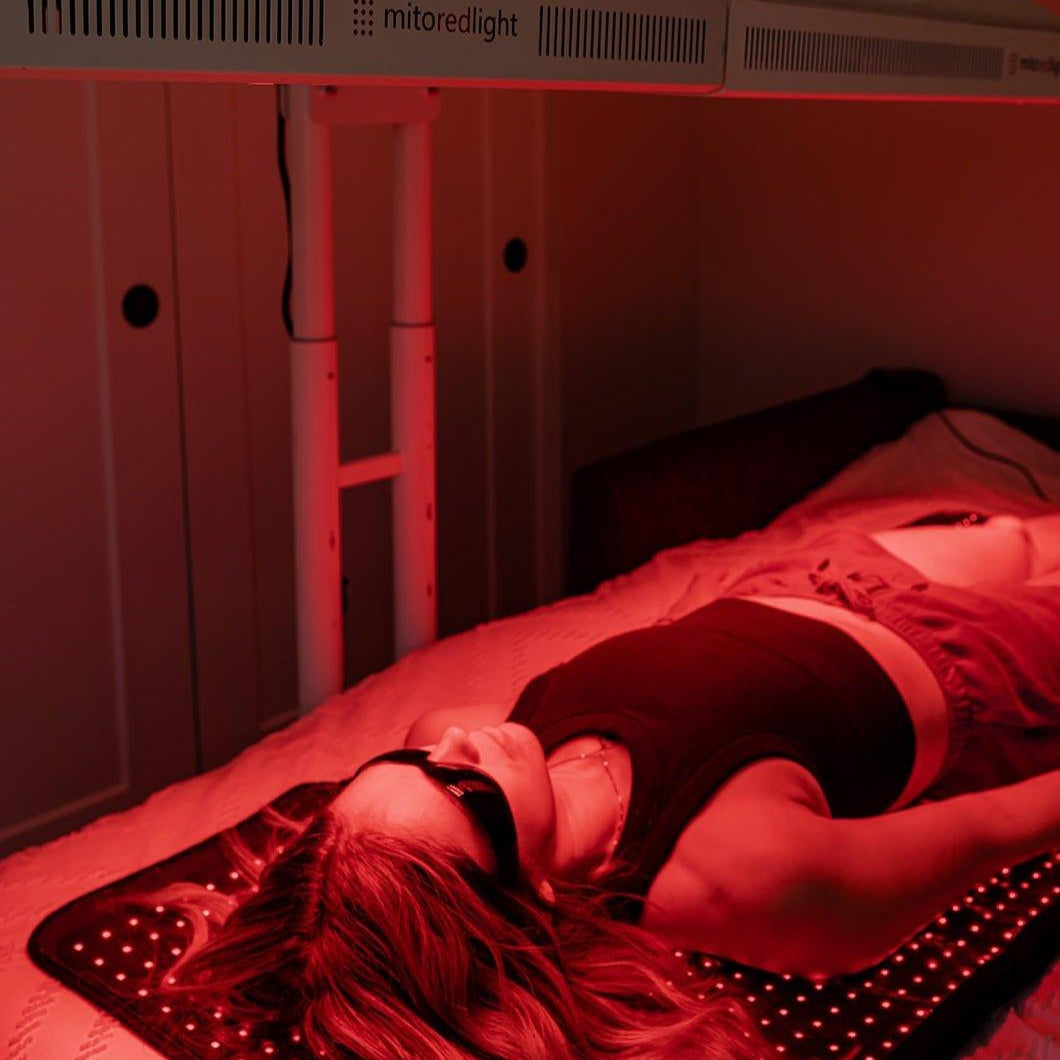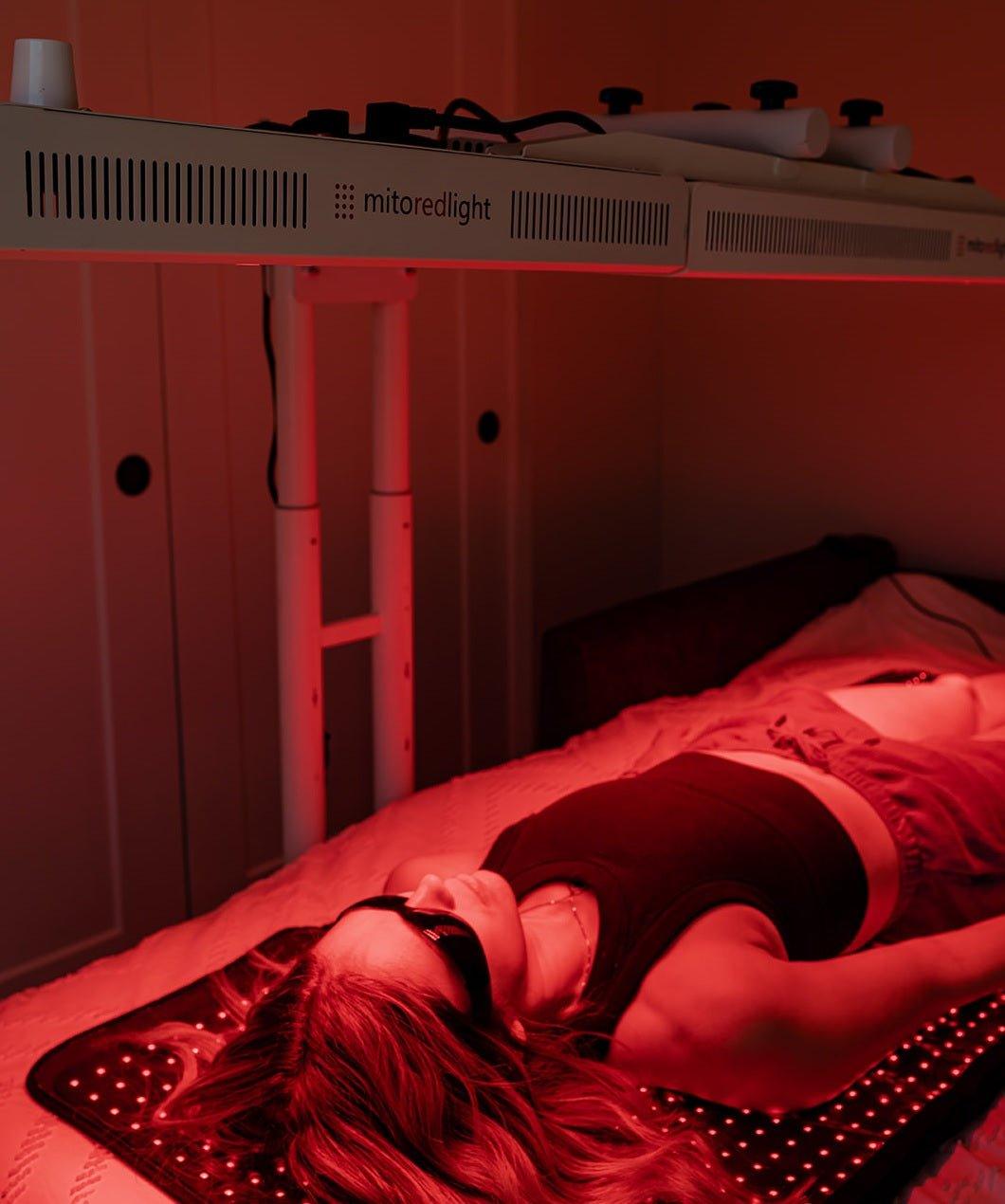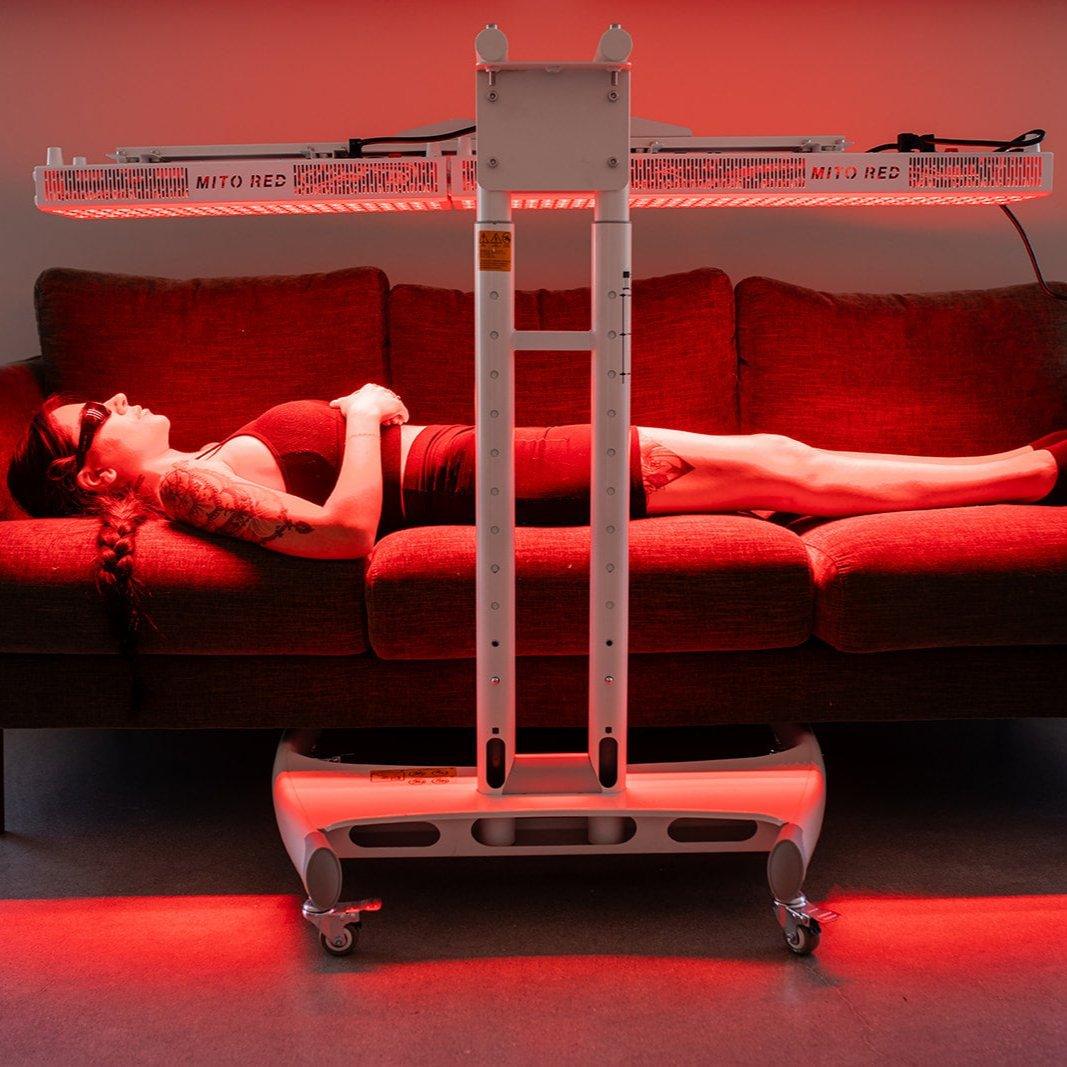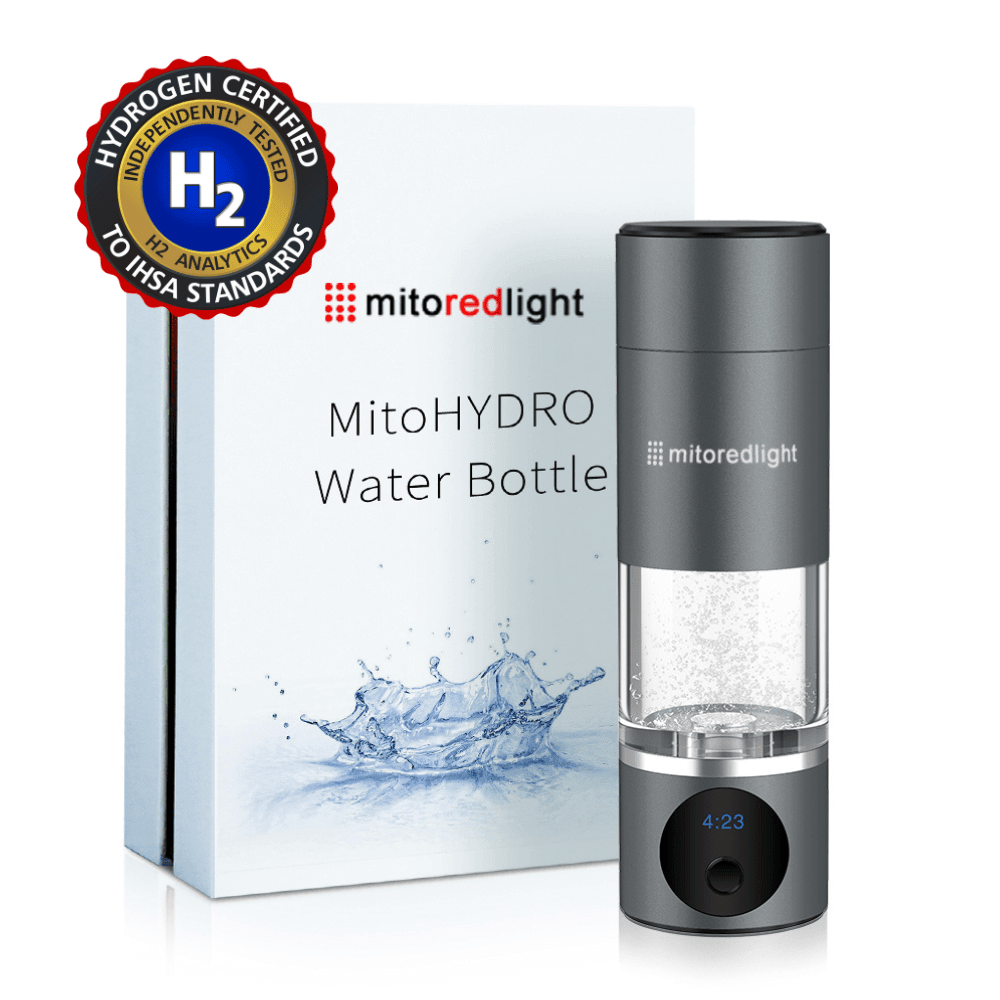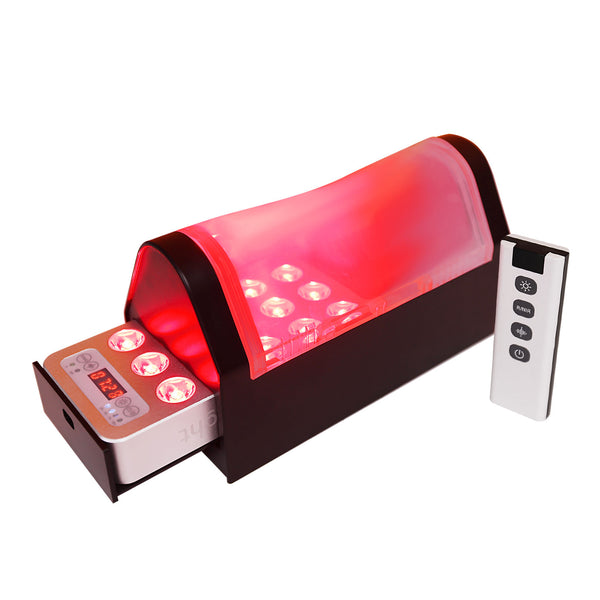DISCLAIMER: Mito Red Light devices are Class II wellness devices aimed at affecting the body through topical heating and supporting cellular function. The information provided in this article and on this site is for educational purposes only and is not intended to imply effectiveness of Mito Red Light devices for any specific application. The information provided in this article and on this site is not intended to diagnose, treat, cure, or prevent any disease, is not a substitute for consultation with a licensed medical provider and should not be construed as medical advice. Click here to read our article on potential contraindications of red light therapy..
Authored By Benjamin Caleb Williams
Combining cervical orthotic block therapy with red light therapy offers a promising approach for those seeking to enhance their holistic health and well-being. While research on this combination is still in its infancy, there is reason to believe that the integration of these two therapies could potentially help individuals achieve better cervical spine alignment, reduced pain, and improved overall neck health. In this article, we’ll explore the benefits and applications of both therapies, providing a comprehensive guide for those interested in exploring this innovative health approach.
Why Does Cervical Neck Health Matter?
The cervical spine plays a crucial role in supporting the head and facilitating its movement. This part of the spine is highly susceptible to strain and injury due to its flexibility and the weight it supports. Issues such as poor posture, prolonged computer use, and physical trauma can lead to cervical spine problems, including neck pain, stiffness, and reduced mobility.
Maintaining cervical neck health [1] is essential for overall well-being. A healthy cervical spine ensures proper alignment, minimizes discomfort, and supports the nervous system's function. Various therapies and exercises can help maintain or restore cervical spine health, and proactive care is important for preventing long-term issues.
Overview of Cervical Orthotic Blocks
Cervical orthotic blocks are therapeutic tools designed to support and restore the natural curvature of the cervical spine. They apply gentle pressure, sometimes called traction, to specific areas of the neck, promoting spinal alignment and relieving tension. Chiropractors and physical therapists often recommend them as part of a comprehensive treatment plan for neck pain and postural correction.
Overview of Red Light Therapy
Red light therapy is a non-invasive treatment that uses specific wavelengths of red and near-infrared light to penetrate the skin and stimulate cellular energy production. This therapy has gained popularity for its potential to reduce inflammation, accelerate healing, and alleviate pain. Red light therapy has been well studied and is thought to work by enhancing the function of mitochondria [2], the energy center of the cell, leading to increased energy production within cells and promoting tissue repair and regeneration.
Research has shown that red light therapy can be effective in treating various conditions, including musculoskeletal pain, skin disorders, and even mood-related issues. Its application in cervical spine health is promising, as it may help reduce inflammation and pain in the neck area, complementing other therapeutic interventions like cervical orthotic block therapy.
Understanding the Cervical Spine
The cervical spine [3], located in the neck region, consists of the top seven vertebrae of the spine. They are labeled C1 through C7, with C1 sitting directly under the skull. This vital, sensitive part of the spine supports the skull, protects the spinal cord, and allows for a wide range of head movements. The cervical spine's unique structure enables flexibility and mobility but can also be susceptible to various problems due to its complexity and the stress it can encounter. Understanding the cervical spine's anatomy and function is essential for appreciating the importance of maintaining its health and addressing any issues that arise.
Healthy Cervical Spine
A healthy cervical spine [4] is characterized by a natural curve that resembles a gentle forward curve when viewed from the side. This curvature helps distribute the weight of the head evenly and minimizes strain on the vertebrae, discs, and surrounding muscles and ligaments. As the nerves for every part of the body below the head come through the cervical spine, proper alignment and curvature of this area of the spine are crucial for maintaining balance, flexibility, and overall spinal health.
Maintaining a healthy cervical spine involves having good posture, engaging in regular exercise, and following ergonomic practices. Activities that strengthen the neck and shoulder muscles improve flexibility, and promote proper alignment can reduce the risk of many common cervical spine issues. Paying attention to posture during daily activities, such as sitting, standing, and sleeping, can also help reduce the risk of developing neck pain and other related problems.
Problems of the Cervical Spine
The cervical spine is prone to various issues that can lead to pain, discomfort, and reduced mobility. Common problems include cervical spondylosis, herniated discs, and muscle strain. Cervical spondylosis, often referred to as neck arthritis, involves the degeneration of the cervical discs and vertebrae due to aging and wear and tear. Herniated discs occur when the soft inner material of a cervical disc protrudes through its outer layer, potentially compressing nearby nerves and causing pain.
Muscle strain is another frequent issue, often resulting from poor posture, overuse, excessive strain, or sudden movements. The sudden movements of the head in car accidents or other type of trauma can be particularly harmful to the cervical spine These problems can lead to symptoms such as neck pain, stiffness, headaches, and pain that radiates into the shoulders and arms. Identifying and addressing cervical spine problems early is crucial for preventing chronic conditions and maintaining overall spinal health.
Traditional Cervical Spine Health Methods
Traditional methods of maintaining cervical spine health often involve non-invasive treatments aimed at reducing pain, improving mobility, and preventing further injury. Here are some of the most commonly used methods:
- Physical therapy exercises and stretches - Physical therapy [5] involves exercises and stretches specifically designed to strengthen the neck muscles, enhance flexibility, and promote proper alignment. These exercises can help alleviate pain and improve overall neck function, making it easier to perform daily activities without discomfort.
- Manual therapy techniques - Physical therapists or other practitioners sometimes use manual therapy techniques, such as massage and mobilization, to relieve muscle tension and improve joint function. These techniques can help reduce pain, increase range of motion, and improve the overall health of the cervical spine.
- Chiropractic adjustments - Chiropractors use hands-on techniques to correct misalignments and restore proper function [6] to the cervical spine. Spinal adjustments and manipulations may alleviate pain, improve mobility, and enhance overall spinal health.
- Massage therapy - Massage therapy helps relieve muscle tension and improve blood circulation. Regular massage can reduce pain, improve flexibility, and promote relaxation, contributing to better cervical spine health.
- Ergonomic modifications in daily activities - Making ergonomic adjustments to daily activities, such as improving posture, using supportive chairs, and arranging workspaces to reduce neck strain, can proactively help maintain cervical spine health. These modifications can help prevent strain and injury, ensuring the neck remains healthy and pain-free.
Understanding Cervical Orthotic Blocks
Cervical orthotic blocks [7] are therapeutic devices designed to support and realign the cervical spine. These blocks are typically used in physical therapy, chiropractic care, and home exercises to help alleviate neck pain, improve posture, and enhance the overall health of the cervical spine. By providing targeted support and gentle pressure, cervical orthotic blocks can help promote the natural curvature of the neck, reduce muscle tension, and aid in the recovery from various cervical spine conditions.
What Are They?
Cervical orthotic blocks are specially designed tools made from firm, supportive materials, such as foam or plastic. They are contoured to fit the natural shape of the neck and upper back, providing support to the cervical spine when a person lies down on them. The natural weight of the head provides gentle pressure against the cervical spine against the block, helping to maintain or restore its healthy curvature.
Cervical blocks come in various shapes and sizes, enabling users to select the most appropriate one for their specific condition and comfort level. They are often used in combination with other therapeutic modalities, such as stretching and strengthening exercises, to maximize their effectiveness. Cervical orthotic blocks are portable, easy to use, and can be incorporated into a daily routine to support long-term neck health.
How Do They Work?
Cervical orthotic blocks work by applying gentle pressure [8] to the cervical spine, encouraging the vertebrae to realign into their natural position. This is a gentle, natural process and does not forcefully adjust the vertebra.
When someone lies on the block, the device's contoured shape supports the neck's natural curve, helping to restore proper alignment and reduce strain on the muscles and ligaments. This realignment can alleviate pain, improve posture, and enhance overall spinal health.
Cervical orthotic blocks can also help to stretch the muscles and ligaments in the neck and upper back. By gently extending these tissues, the blocks can reduce muscle tension, increase flexibility, and promote better circulation. Regular use of cervical orthotic blocks can lead to long-term improvements in neck function and comfort, making them a valuable tool in managing chronic neck pain and other cervical spine issues.
Common Reasons People Use Them
People use cervical orthotic blocks for a variety of reasons, often related to the prevention and treatment of neck pain and postural issues. Some of the most common reasons include:
- Neck pain relief - Cervical orthotic blocks can help alleviate pain caused by conditions such as cervical spondylosis, herniated discs, and muscle strain.
- Posture improvement - Cervical orthotic blocks can help correct poor posture by promoting proper alignment of the cervical spine, reducing the risk of developing chronic neck and back problems.
- Injury recovery - Cervical orthotic blocks can aid in the recovery process following neck injuries, providing support and promoting healing.
- Stress Reduction - The gentle stretching and relaxation provided by cervical orthotic blocks may help reduce stress and tension in the neck and upper back.
- Prevention - Regular use of cervical orthotic blocks can help prevent the development of neck pain and postural issues by maintaining proper alignment and flexibility.
Understanding Red Light Therapy
Red light therapy is a non-invasive, holistic therapy that uses specific wavelengths of red and near-infrared light to stimulate cells. This therapy has gained widespread popularity due to its ability to promote healing, reduce inflammation, and alleviate pain. By enhancing cellular function, red light therapy offers a natural and effective approach to improving overall health and well-being.
What Is It?
Red light therapy involves exposing the body to low-level wavelengths of red and near-infrared light. These wavelengths penetrate deep below the skin and are thought to be absorbed by a chemical in cells called cytochrome C oxidase. This chemical plays an important role in energy production within mitochondria, small organs inside of most types of cells.
Red light therapy is provided using devices such as panels, lamps, or handheld units, which deliver the light to the targeted areas of the body. Sessions typically last for a few minutes and can be done at home or in settings like dermatology offices or spas. Red light therapy is almost always painless and has no known side effects, making it a popular choice for individuals seeking natural holistic ways to promote a healthy lifestyle.
How Does It Work?
Red light therapy works by penetrating the skin and being absorbed by the mitochondria, the energy-producing organelles within cells. The light energy is believed to stimulate the production of adenosine triphosphate (ATP), the primary energy carrier in cells. This increase in ATP production is thought to enhance cellular function, leading to improved cell repair, regeneration, and overall health.
In addition to boosting ATP production [9], red light therapy also promotes increased blood flow and circulation by stimulating the release of nitric oxide. This helps to increase the delivery of oxygen and nutrients to the tissues, further supporting healing and reducing inflammation. The combined effects of enhanced cellular energy and improved circulation make red light therapy a popular treatment for a wide range of conditions, from skin issues to musculoskeletal pain.
What Kind of Science Supports It?
While research into how red light therapy works and what effects it has is still ongoing, numerous scientific studies have demonstrated the effectiveness of red light therapy in various situations. Research has shown that red light therapy can significantly reduce pain and inflammation, accelerate wound healing, and improve skin health. Clinical trials have also found that red light therapy can enhance muscle recovery, reduce joint pain, and promote hair growth.
One study [10] published in the International Journal of Tissue Reactions found that red light therapy improved neck pain with just two treatments for twelve out of fourteen people with osteoarthritis, highlighting its potential for musculoskeletal conditions. Another study [11] published in Physiotherapy demonstrated that red light therapy can improve pain and range of motion in individuals with neck pain. These studies and many others provide strong evidence supporting the use of red light therapy for various health benefits.
Common Reasons People Use Red Light Therapy
People use red light therapy for a variety of reasons, seeking its benefits for different health conditions and wellness goals. Some of the most common reasons include:
- Pain relief - Red light therapy is often used to alleviate acute or chronic pain [12], including joint pain, muscle soreness, and inflammation.
- Skin health - Many individuals use red light therapy to improve skin conditions such as acne, wrinkles, and scars or to improve the overall quality and health of their skin.
- Wound healing - Red light therapy can accelerate the healing process [13] for cuts, burns, and other wounds.
- Hair growth - Red light therapy is used to stimulate hair growth and reduce hair loss.
- Sleep promotion - Red light therapy can help improve the quality and duration of sleep, making it a popular option for those who struggle to sleep well.
- Muscle recovery - Athletes and active individuals use red light therapy to enhance muscle recovery [14] and reduce soreness after workouts.
As research continues to develop, more potential applications of red light therapy are being discovered, and new uses are emerging. The versatile nature of red light therapy also contributes to its continued growth.
Combining Cervical Orthotic Blocks with Red Light Therapy
Combining cervical orthotic block therapy with red light therapy provides an innovative and holistic approach to improving cervical spine health. This new method leverages the mechanical support and alignment benefits of cervical orthotic blocks with the cellular and therapeutic advantages of red light therapy.
While this combination has not yet specifically been researched, combining these therapies may enable individuals to achieve enhanced pain relief, improved posture, and faster recovery from neck injuries. This combined approach has the potential to be particularly beneficial for those suffering from chronic neck pain or looking to prevent future cervical spine issues.
Overview of the MitoCHIRO™ Neck Pillow
The MitoCHIRO™ Neck Pillow is a state-of-the-art device designed to provide both cervical orthotic support and red light therapy in one convenient product. This innovative pillow is contoured to fit the natural curvature of the cervical spine, promoting proper alignment and relieving tension in the neck and upper back. Made from high-quality, supportive materials, the MitoCHIRO™ Neck Pillow ensures comfort while effectively addressing postural issues and neck pain.
In addition to its ergonomic design, the MitoCHIRO™ Neck Pillow is equipped with embedded red light therapy technology. This feature delivers targeted wavelengths of red and near-infrared light to the neck area, stimulating cellular function and promoting healing. By integrating these two therapies, the MitoCHIRO™ Neck Pillow offers a comprehensive solution for those seeking to enhance their cervical spine health and overall well-being.
Rationale for Combination
Combining cervical orthotic blocks with red light therapy is a new approach and has not yet been researched. The rationale behind this approach lies in the complementary benefits that each therapy provides.
Cervical orthotic blocks are effective in restoring the natural curvature of the neck, reducing strain on muscles and ligaments, and improving posture. However, while they provide mechanical support and alignment, they do not directly address cellular function or inflammation.
Red light therapy, on the other hand, works at the cellular level to reduce inflammation, promote healing, and enhance tissue regeneration. A study [15] published in Lasers in Medical Science showed that the effects of red light therapy combined with exercise was more effective at treating cervical neck pain than ultrasound therapy combined with exercise or exercise alone.
By stimulating the mitochondria in cells, red light therapy increases energy production and supports overall cellular health. When used together, these therapies address both the structural and cellular aspects of cervical spine health, offering a more holistic approach to both treatment and prevention.
Potential Synergistic Effects
Combining cervical orthotic blocks with red light therapy is a new approach and it is too early to say for certain that this combination provides synergistic benefits. There is however, good reason to believe that they will complement each other and provide a synergistic effect.
Synergy describes the idea that by using these therapies simultaneously, individuals can experience enhanced benefits that surpass those achieved by using either therapy alone. The structural support provided by the cervical orthotic block is designed to help maintain proper alignment, while the red light therapy reduces inflammation [16] and promotes healing at the cellular level. The intention is that this synergy will lead to faster recovery times from neck injuries, more effective pain relief, and improved overall neck function when compared to either option by itself.
What Does the Science Show?
Scientific research supports the effectiveness of both cervical orthotic blocks and red light therapy, improving neck health separately. Studies have demonstrated that cervical orthotic blocks can significantly improve cervical alignment, reduce pain, and enhance posture.
Research also shows that when red light therapy is combined with other treatment tools, the effectiveness of both can be increased and that red light therapy can help treat neck pain.
- A study [17] published in 2023 in the Journal of Lasers in Medical Sciences demonstrated that a tool used to treat joint problems affecting the jaw resulted in “improved functionality and outcomes.”
- Research [18] published in 2022 in Cureus showed that using phototherapy to augment a device treating a skeletal deformity resulted in a 45% increase in the effects of the device.
- A study [19] published in 2022 in the Journal of Lasers in Medical Sciences showed that red light therapy is a “a non-invasive, safe and effective method that can improve chronic nonspecific neck pain.”
- A study [20] published in 2024 in Bioengineering & Translational Medicine demonstrated that phototherapy could not only help with neck pain, but even promote the regeneration of nerve cells and support recovery of lost function after a spinal cord injury.
While these studies do not offer proof of a synergistic effect when using cervical orthotic blocks and red light therapy together therapies together, they do provide a solid foundation for the idea that this combination will be beneficial. Ultimately, they do suggest that it is reasonable to assume that an integrative approach could offer enhanced therapeutic outcomes.

Introducing the MitoCHIRO™ Neck Pillow
The MitoCHIRO™ Neck Pillow is a first-of-its-kind product designed to revolutionize cervical spine care by combining the therapeutic benefits of cervical orthotic support with advanced red light therapy. This cutting-edge pillow aims to provide users with comprehensive neck pain relief, improved posture, and enhanced overall well-being, making it a unique and innovative addition to any health and wellness routine.
Benefits That It is Designed to Provide
The MitoCHIRO™ Neck Pillow has been specifically designed to offer a range of benefits that cater to various aspects of cervical spine health. By integrating both cervical orthotic support and red light therapy, this pillow addresses structural alignment and cellular health simultaneously.
There are several benefits that the MitoCHIRO™ Neck Pillow was designed to help people ahcieve. By promoting proper spinal alignment and enhancing circulation through red light therapy, the pillow is inteded to help users wake up feeling refreshed and free from the discomfort that often accompanies poor sleeping posture or prolonged periods of inactivity.
While this tool is new, and it is impossible to know for sure what its impact will be, some of the benefits that it was specifically designed to potentially help with include:
- Significant relief from chronic neck pain - The MitoCHIRO™ Neck Pillow aims to alleviate chronic neck pain through proper spinal alignment and support.
- Improved posture - The MitoCHIRO™ Neck Pillow is designed to enhance posture by promoting the natural curvature of the cervical spine.
- Accelerated healing from neck injuries - The pillow integrates features that may speed up the recovery process from neck injuries.
- Reduced muscle tension and stress - The MitoCHIRO™ Neck Pillow is intended to reduce muscle tension and stress through its supportive design and therapeutic features.
- Enhanced circulation and cellular health - Red light therapy is incorporated into the pillow to potentially boost circulation and improve cellular health.
Features It Offers
The MitoCHIRO™ Neck Pillow boasts several features designed to optimize user comfort and therapeutic efficacy. Its ergonomic design conforms to the natural curvature of the cervical spine, providing necessary support and promoting proper alignment. The pillow's high-quality materials ensure durability and comfort, making it suitable for long-term use.
One of the standout features of the MitoCHIRO™ Neck Pillow is its built-in red light therapy technology. This delivers targeted wavelengths of red and near-infrared light directly to the neck area, enhancing cellular function and promoting healing. The red light is illuminated directly into the translucent pillow material, providing an even spread of the light over the target area.
The pillow also includes adjustable settings that can be controlled via a wireless remote, allowing users to customize the intensity and duration of the red light therapy to suit their individual needs. The red light component can be removed from the pillow, making it easy to maintain.
How the MitoCHIRO™ Neck Pillow is Unique
The MitoCHIRO™ Neck Pillow stands out in the market due to its truly unique combination of cervical orthotic support and red light therapy. While many products for cervical spine health focus on either structural support or cellular health, the MitoCHIRO™ Neck Pillow integrates both, providing a comprehensive approach to cervical spine care.
This dual functionality makes it an invaluable tool for those looking to address multiple aspects of neck health simultaneously. This function also saves time, providing the benefits of a cervical orthotic block and red light therapy simultaneously.
Tips for Using the MitoCHIRO™ Neck Pillow
Begin by lying down on the pillow with your neck properly aligned with the contour of the pillow. Adjust the red light therapy settings to your comfort level and use the therapy for the recommended duration, typically around 10-20 minutes per session. From there, alsl you need to do is relax, and let the pillow do its work.
There are several ways to maximize the benefits of the MitoCHIRO™ Neck Pillow. Our top tips for those using the MitoCHIRO™ Neck Pillow include:
- Always ensure you are using it correctly and following the directions.
- Be consistent in your use of the pillow. Regular use will yield the best results.
- Ensure your neck is well aligned with the pillow contour. This helps to ensure that it is applying pressure to the correct area.
- Combine with good posture and neck exercises for optimal results.
For the best results, you should consider incorporating the MitoCHIRO™ Neck Pillow into your daily routine. Consistent use will help maintain proper cervical spine alignment and enhance the healing effects of red light therapy.
The Future of Cervical Neck Health
The future of cervical neck health is poised to benefit from ongoing advances in technology and scientific research. With a growing understanding of the complex interplay between spinal alignment, cellular function, and overall health, innovative treatments like the MitoCHIRO™ Neck Pillow are leading the way.
These advancements are likely to result in increasingly effective, non-invasive solutions for those suffering from neck pain and related conditions, enhancing quality of life and promoting long-term spinal health.
Overview of Current Science
Current science in cervical neck health is focused on understanding the intricate mechanisms that contribute to spinal alignment, pain relief, and overall function. Researchers are exploring the biomechanical aspects of the cervical spine, examining how posture, repetitive movements, and injuries impact the vertebrae, discs, and surrounding muscles and ligaments. This knowledge is crucial for developing targeted therapies that address the root causes of neck pain and dysfunction.
In addition to biomechanical research, there is significant interest in the cellular and molecular processes involved in inflammation, healing, and tissue regeneration. Studies on red light therapy, for instance, have shown its effectiveness in reducing inflammation, promoting cellular repair, and accelerating recovery from injuries. This dual focus on mechanical and cellular health is paving the way for more comprehensive treatment approaches that address both structural and biological factors in cervical spine health.
The MitoCHIRO™ Neck Pillow’s Role in Current Science
The MitoCHIRO™ Neck Pillow represents the cutting edge of cervical neck health technology by integrating advanced cervical orthotic support with red light therapy. This innovative approach addresses both the structural alignment of the cervical spine and the cellular processes that underpin healing and pain relief. By combining these therapies, the MitoCHIRO™ Neck Pillow offers a holistic solution that targets multiple aspects of neck health simultaneously.
What is the Future of Cervical Spine Health Research?
The future direction of research in cervical neck health is likely to continue focusing on the integration of multi-modal therapies and the development of personalized treatment approaches. As technology advances, we can expect to see more sophisticated devices that combine various therapeutic modalities, providing comprehensive solutions for neck pain and dysfunction.
Research will likely delve deeper into understanding the precise mechanisms through which these therapies interact and enhance each other’s effects. Tools like the MitoCHIRO™ Neck Pillow are expected to provide meaningful results to spine health; however, the actual results and their long-term effectiveness will need to be researched to be fully understood.
Overall, the future of cervical neck health looks bright, with ongoing research and technological advancements paving the way for innovative, effective, and accessible treatments. As our understanding of the cervical spine and its complex functions continues to grow, so too will the options available for maintaining and improving neck health, ultimately enhancing the quality of life for countless individuals.
Conclusion
Combining cervical orthotic block therapy with red light therapy offers a comprehensive and innovative approach to cervical spine health. This integration provides a powerful solution for those seeking to alleviate neck pain, improve posture, and enhance overall well-being. By leveraging the strengths of both therapies, individuals can achieve superior results in maintaining and restoring their cervical spine health.
Summary of The MitoCHIRO™ Neck Pillow Potential Benefits
The MitoCHIRO™ Neck Pillow, which combines cervical orthotic support and red light therapy, offers a multitude of potential benefits. It addresses both structural and cellular health, ensuring that users receive comprehensive care.
The ergonomic design promotes proper cervical spine alignment, which helps to alleviate neck pain, reduce muscle tension, and improve posture. This structural support is crucial for maintaining the health of the cervical spine and preventing future issues.
Red light therapy enhances these benefits by stimulating cellular function and promoting healing. The therapy may help reduce inflammation, increase circulation, and accelerate tissue repair, offering pain relief and faster recovery from neck injuries. The combined use of these therapies in the MitoCHIRO™ Neck Pillow ensures that users experience a holistic approach to neck health, addressing both immediate discomfort and long-term wellness.
Final Thoughts
Investing in the MitoCHIRO™ Neck Pillow is a way to access a new method of potentially achieving better neck health and overall well-being. This innovative product leverages cutting-edge technology to provide a non-invasive, convenient, and effective solution for those struggling with neck pain or looking to prevent it. The integration of cervical orthotic support and red light therapy in one device is a meaningful advancement in holistic health solutions, offering a more comprehensive approach than traditional methods alone.
As our understanding of cervical spine health continues to evolve, the importance of combining different therapeutic modalities is becoming increasingly promising. Products like the MitoCHIRO™ Neck Pillow exemplify how modern technology can be harnessed to provide more effective, multi-faceted health solutions. By addressing both structural alignment and cellular health, this pillow sets a new standard for cervical spine care, making it an essential tool for anyone serious about their neck health.
Exploring the MitoCHIRO™ Neck Pillow
At Mito Red we are committed to innovation and offering the best red light therapy at home solutions anywhere. Take the first step towards improved neck health and overall well-being by exploring the MitoCHIRO™ Neck Pillow. Visit our website today to learn more about the MitoCHIRO™ Neck Pillow and discover how it can transform your approach to cervical spine health. Invest in your health and experience the future of neck care with MitoCHIRO™.
References:
- Kazeminasab, S., Nejadghaderi, S. A., Amiri, P., Pourfathi, H., Araj-Khodaei, M., M. Sullman, M. J., Kolahi, A., & Safiri, S. (2022). Neck pain: Global epidemiology, trends and risk factors. BMC Musculoskeletal Disorders, 23. https://doi.org/10.1186/s12891-021-04957-4
- Tafur, J., & Mills, P. J. (2008). Low-Intensity Light Therapy: Exploring the Role of Redox Mechanisms. Photomedicine and Laser Surgery, 26(4), 323-328. https://doi.org/10.1089/pho.2007.2184
- Windsor, R. E. (2017). Cervical Spine Anatomy. Medscape. Retrieved from https://emedicine.medscape.com/article/1948797-overview
- Rezai, M., Côté, P., Cassidy, J. D., & Carroll, L. (2009). The association between prevalent neck pain and health-related quality of life: A cross-sectional analysis. European Spine Journal, 18(3), 371-381. https://doi.org/10.1007/s00586-008-0823-6
- de Zoete, R. M. J. (2023). Exercise Therapy for Chronic Neck Pain: Tailoring Person-Centred Approaches within Contemporary Management. Journal of Clinical Medicine, 12(22). https://doi.org/10.3390/jcm12227108
- Haneline, M. T., & Cooperstein, R. (2009). Chiropractic care for patients with acute neck pain: Results of a pragmatic practice-based feasibility study. Journal of Chiropractic Medicine, 8(4), 143-155. https://doi.org/10.1016/j.jcm.2009.08.003
- Pangarkar, S., & Lee, P. C. (2011). Conservative Treatment for Neck Pain: Medications, Physical Therapy, and Exercise. Physical Medicine and Rehabilitation Clinics of North America, 22(3), 503-520. https://doi.org/10.1016/j.pmr.2011.04.001
- Fazli, F., Farahmand, B., Azadinia, F., & Amiri, A. (2019). The Effect of Ergonomic Latex Pillow on Head and Neck Posture and Muscle Endurance in Patients With Cervical Spondylosis: A Randomized Controlled Trial. Journal of Chiropractic Medicine, 18(3), 155-162. https://doi.org/10.1016/j.jcm.2019.02.003
- Begum, R., Calaza, K., Kam, J. H., Salt, T. E., Hogg, C., & Jeffery, G. (2015). Near-infrared light increases ATP, extends lifespan and improves mobility in aged Drosophila melanogaster. Biology Letters, 11(3). https://doi.org/10.1098/rsbl.2015.0073
- Monteforte, P., Baratto, L., Molfetta, L., & Rovetta, G. (2003). Low-power laser in osteoarthritis of the cervical spine. International Journal of Tissue Reactions, 25(4), 131-136. Retrieved from https://pubmed.ncbi.nlm.nih.gov/15244318/
- Xie, Y.-H., Liao, M.-X., Lam, F. M. H., Gu, Y.-M., Fernando, W. C. H. A., Liao, L.-R., & Pang, M. Y. C. (2023). The effectiveness of high-intensity laser therapy in individuals with neck pain: A systematic review and meta-analysis. Physiotherapy, 121, 23-36. https://doi.org/10.1016/j.physio.2023.07.003
- De Oliveira, M. F., Johnson, D. S., Demchak, T., Tomazoni, S. S., & Leal-Junior, E. C. (2022). Low-intensity LASER and LED (photobiomodulation therapy) for pain control of the most common musculoskeletal conditions. European Journal of Physical and Rehabilitation Medicine, 58(2), 282-289. https://doi.org/10.23736/S1973-9087.21.07236-1
- Giannakopoulos, E., Katopodi, A., Rallis, M., Politopoulos, K., & Alexandratou, E. (2023). The effects of low power laser light at 661 nm on wound healing in a scratch assay fibroblast model. Lasers in Medical Science, 38(1). https://doi.org/10.1007/s10103-022-03670-5
- Odagiri, K., Yamauchi, K., Toda, M., Uchida, A., Tsubota, H., Zenba, K., Okawai, H., Eda, H., Mizuno, S., & Yokota, H. (2022). Feasibility study of a LED light irradiation device for the treatment of chronic neck with shoulder muscle pain/stiffness. PLoS ONE, 17(10). https://doi.org/10.1371/journal.pone.0276320
- Rabie, G. M., Shokry, K. E., & Alsharnoubi, J. (2023). Short-term effects of low-level laser versus ultrasound therapy on children's neck posture after long-term use of electronic devices. Lasers in Medical Science, 38(1), 235. https://doi.org/10.1007/s10103-023-03895-y
- Tehrani, M. R., Nazary-Moghadam, S., Zeinalzadeh, A., Moradi, A., Mehrad-Majd, H., & Sahebalam, M. (2022). Efficacy of low-level laser therapy on pain, disability, pressure pain threshold, and range of motion in patients with myofascial neck pain syndrome: A systematic review and meta-analysis of randomized controlled trials. Lasers in Medical Science, 37(9), 3333-3341. https://doi.org/10.1007/s10103-022-03626-9
- Agha Aghili, H., Yassaei, S., & Sharifi, M. (2023). Effect of low-level laser therapy on patients with Class II mandibular deficiency treated with Farmand functional appliance. Journal of Lasers in Medical Sciences, 14, e12. https://doi.org/10.34172/jlms.2023.12
- Abdulhadi, A., Burhan, A. S., Hajeer, M. Y., Hamadah, O., Mahmoud, G., Nawaya, F. R., & Namera, M. O. (2022). Evaluation of the functional treatment of patients with skeletal Class II malocclusion using low-level laser therapy-assisted Twin-Block appliance: A three-arm randomized controlled trial. Cureus, 14(3), e23449. https://doi.org/10.7759/cureus.23449
- Momenzadeh, S., Zali, A., Razzaghi, Z., Momenzadeh, F., Mirkheshti, A., Sayadi, S., Teymourian, H., & Momenzadeh, R. (2022). Efficacy of Low-Level Laser Therapy for the Treatment of Nonspecific Chronic Neck Pain: Low-Level Laser Therapy vs. Sham Laser. Journal of Lasers in Medical Sciences, 13. https://doi.org/10.34172/jlms.2022.74
- Stevens, A. R., Hadis, M., Phillips, A., Thareja, A., Milward, M., Belli, A., Palin, W., Davies, D. J., & Ahmed, Z. (2024) Implantable and transcutaneous photobiomodulation promote neuroregeneration and recovery of lost function after spinal cord injury. Bioengineering & Translational Medicine, e10674. https://doi.org/10.1002/btm2.10674




